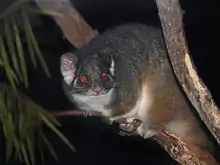Pseudocheirus
Pseudocheirus is a genus of ringtail possums (family Pseudocheiridae). It includes a single living species, the common ringtail possum (Pseudocheirus peregrinus) of Australia, as well as the fossil Pseudocheirus marshalli from the Pliocene of Victoria.[1]
| Pseudocheirus | |
|---|---|
 | |
| Common ringtail possum (Pseudocheirus peregrinus) | |
| Scientific classification | |
| Domain: | Eukaryota |
| Kingdom: | Animalia |
| Phylum: | Chordata |
| Class: | Mammalia |
| Infraclass: | Marsupialia |
| Order: | Diprotodontia |
| Family: | Pseudocheiridae |
| Subfamily: | Pseudocheirinae |
| Genus: | Pseudocheirus Ogilby, 1837 |
| Species | |
| |
Other species have previously been included in this genus. Most other ringtails—the lemur-like ringtail (Hemibelideus lemuroides), the rock-haunting ringtail (Petropseudes dahli), and the various species of Pseudochirulus and Pseudochirops—were classified in Pseudocheirus until the 1980s or 1990s.[2] A second ringtail from the Victorian Pliocene, Petauroides stirtoni, was originally named as a Pseudocheirus, but is now considered to be more closely related to the greater glider (Petauroides volans).[3]
The genus was erected by William Ogilby in 1837, the same author later using then correcting the spelling Pseudochirus that is now regarded as a nomenclatural synonym used in error by authors such as Oldfield Thomas.[4]
Taxonomic opinion favours treatment of the western population, Pseudocheirus peregrinus occidentalis, as a separate species (Pseudocheirus occidentalis), though the contradictory evidence from current studies have prevented this recommendation being published.[5]
References
- Turnbull et al., 2003, p. 533; Groves, 2001, p. 51
- Groves, 2001, pp. 50–53
- Turnbull et al., 2003, p. 533
- "Genus Pseudocheirus Ogilby, 1837". Australian Faunal Directory. biodiversity.org.au. Retrieved 19 June 2019.
- "Pseudocheirus occidentalis — Western Ringtail Possum". Species Profile and Threats Database. Department of Sustainability, Environment, Water, Population and Communities. Retrieved 3 November 2010.
Literature cited
- Groves, C.P. 2005. Order Diprotodontia. Pp. 43–70 in Wilson, D.E. and Reeder, D.M. (eds.). Mammal Species of the World: a taxonomic and geographic reference. 3rd ed. Baltimore: The Johns Hopkins University Press, 2 vols., 2142 pp. ISBN 978-0-8018-8221-0
- Turnbull, W.D., Lundelius, E.R. Jr. and Archer, M. 2003. Dasyurids, perameloids, phalangeroids, and vombatoids from the Early Pliocene Hamilton Fauna, Victoria, Australia. Bulletin of the American Museum of Natural History 279:513–540.